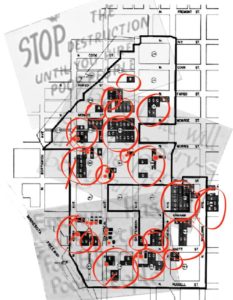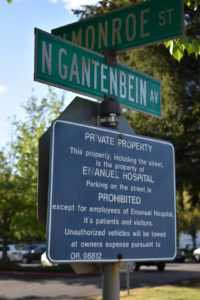

It’s a sunny Saturday afternoon in early April, and a small group meanders down North Williams Street in the Central Albina district. Despite the bustling of cars and people around them, the group pauses often in the middle of the sidewalk to talk or take photos.
The streets are filled with trendy coffee shops and high-rise apartments draped with banners that read “Leasing Now.” The buildings and infrastructure have sharp angles, muted colors and homogenous designs, tell-tale signs of gentrification. Where family homes once stood, half-empty parking lots now serve as painful reminders to former community members.
“It’s insult on top of insult,” says Byrd, who only goes by one name. Byrd, as a librarian, is a trained researcher and she is also a descendant of former Central Albina residents.
There is almost no trace of the original Central Albina neighborhood, except to those who know where to look.
Brought together by a Portland State University project called Crossing the Red Line, this group consists of former residents of Central Albina and survivors of the displacement that occurred here; this area was once their neighborhood, before it was purchased and demolished by the City of Portland in the 1970s. While walking down the streets, community members discuss which corners were once home to childhood friends and neighbors. The alignment of this region is so foreign now that survivors struggle to remember the locations of the stores, houses and community centers from their adolescence.
As the group makes its way through the neighborhood, they start to piece together the original arrangement of Albina: the record shop that hired many teenagers in the neighborhood, the bakery that gave out free pies and pastries, the social club down the street by the barbecue restaurant and a parking lot that used to be the site of many family homes and small businesses. Most of all, they remember a prosperous, happy and healthy Black community.
“We had the kind of neighborhood you just don’t see anymore,” says Marilyn Hasan, who grew up in Albina.
Before the 1970s, Central Albina was a healthy and flourishing community. However, due to efforts by the Emanuel Hospital, now called Legacy Emanuel Hospital, and the City of Portland, this neighborhood was demolished and residents were uprooted.
Nearly 50 years later, survivors of the Emanuel Hospital expansion are fighting for recognition and reparations for the economic, social and psychological harm caused by this displacement.
For Black Portlanders, who have historically been prevented from living in many places, Central Albina was a haven. When Oregon was founded in 1857, Black people were prohibited from living or owning property here. This legacy carried over to Portland, where neighborhoods were zoned to segregate races, and the government used a wide variety of tactics – many of which are still used today – to drain Black neighborhoods, schools and facilities of wealth. Over two-thirds of residents in Albina were Black in the 1960s, and 32% owned their homes outright. According to the U.S. Census Bureau, homeowners have a median net worth eighty times that of renters.
Despite this apparent prosperity, Central Albina was declared blighted in the 1960s by the City of Portland and the Portland Development Commission (PDC), now called Prosper Portland), which allowed for its eventual destruction in order to make way for an expansion of the Emanuel Hospital that ultimately did not use all of the seized land.
Ira Keller, PDC’s first chair, also played a significant role in classifying Albina as blighted, and stated that he was concerned with the “high concentration of Negroes in Central Albina.” While Keller was one of the most prominent voices in the denigration of this neighborhood, it was a collective effort on the part of white government housing officials, bankers, realtors, landlords and other white organizations.
In Oregon “blighted areas” are “areas that, by reason of deterioration, faulty planning, inadequate or improper facilities, deleterious land use or the existence of unsafe structures, or any combination of these factors, are detrimental to the safety, health or welfare of the community.” Once labeled as blighted, Albina was vulnerable to exploitation. In Portland, areas legally labeled as blighted are eligible to be approved as urban renewal zones, which allows land and funding needed for construction to be allocated to those areas.
In 1967, through the Portland City Council, PDC and the Department of Housing and Urban Development (HUD), Emanuel Hospital purchased significant portions of the Albina area to develop and was given funding by the city to expand into the land. The hospital planned to use this area to expand its nursing program.
While the expansion was in the works for nearly a decade, neither the City nor PDC notified residents of their plans. The first public meeting for those affected was not held until July 1970, three years after the plan was approved. The city held a public hearing to adopt the urban renewal plan. However, most residents were not aware of the meetings. Instead, they were notified of the loss of their house through notes, letters or home visits.
“The way you found out is there was a note left on your door telling you to move out of the house you had lived in for 25, 30, 35 years, the home that you’ve owned, that you’ve built up, that you’ve remodeled,” says Byrd.
Shortly after the city approved the plan, a group of residents calling themselves the Emanuel Displaced Persons Association (EDPA) came forward to protest the lack of compensation for the homes and affordable and convenient relocation options, as well as the ineffective communication by PDC.
EDPA would go in front of the city twice to oppose the expansion. Their second complaint was successful, and in March of 1971, EDPA, PDC, the City of Portland and Emanuel signed the Replacement Housing Agreement, which promised relocation assistance for displaced residents as well as to replace the demolished homes with “not less than an equal number of newly-constructed standard housing units” near Central Albina.
The month after the Replacement Housing Agreement was signed, PDC began the relocation process. Although EDPA continued to protest the expansion, they were ultimately unable to permanently halt the project. However, their efforts were not completely in vain.
“If it were not for them, there wouldn’t have been any relocation assistance available for folks,” says Byrd.
In the end, PDC purchased and demolished 188 homes and businesses for the Emanuel Hospital Urban Renewal Project between 1971 and 1973. Those 188 were in addition to the 101 that Emanuel itself had purchased during the 1960s. In total, 171 families, most of whom were Black, were uprooted by PDC. Homes in Central Albina were undervalued during this displacement, meaning that many Black homeowners didn’t receive adequate restitution.
Hasan, a survivor of the Emanuel Hospital displacement, lived with her parents and her five siblings in a house they owned directly behind Emanuel Hospital. Hasan’s great grandmother lived directly across the street, and her grandfather lived right next to her elementary school. She remembers what it was like as an eleven-year-old to be told that she was moving away from her community.
“Everyone was told we had to move because the property, Emanuel Hospital wanted to build on the property,” says Hasan. “They didn’t get a whole lot of time… the time they had given (my father) to look for a home and to move a family of five or six people was, I think 60 days, if that.”
Most residents moved within a few months of each other, and the houses were demolished shortly after. When her father visited their street after a few weeks to retrieve forgotten belongings, their house had already been bulldozed. Despite being fairly sheltered from her family’s displacement during her childhood, Hasan now recognizes the true effects this likely had on the adults in her life.
“I can only imagine having to make that adjustment with (five) kids and two adults and trying to find a big enough house,” she says about her parents.
For many survivors like Hasan, this displacement was a painful fissure from the neighborhood of their childhood.
“Albina was our safe haven,” Hasan says. “That was all I knew until we had to move.”
Central Albina in the 1960s was by all accounts a tight-knit, Black community. During a time when Black people were unwelcome in much of Portland, Albina was largely self-contained out of necessity. People lived, worked and spent most of their time in the community. Countless Black-owned businesses populated the streets, with owners usually living in the area.
“It was a very prosperous neighborhood,” recalls survivor Brian Morris. “There was restaurants, social clubs, record stores, clothing stores, a beauty salon.”
Several generations of families lived in Albina, oftentimes on the same street. Many people in the neighborhood lived in multigenerational houses. Elizabeth Fouther-Branch and her older brother Bobby Fouther, both survivors of the displacement, spent countless hours with their Great Aunt Della, who owned a house just down the block from their family duplex. Weekends, holidays and after-school hours were spent at Aunt Della’s house, a lifeline for their mother, who often worked multiple jobs at a time.
“Aunt Della kind of became the matriarch of the area, because we didn’t really have other families,” says Branch. “We were just there every day, because my mom worked.”
Fouther-Branch recalls a home where neighbors watched out for each other and where “everyone knew everyone.” There were several honorary grandmothers of the neighborhood children, and adults watched over the gaggle of kids that roamed the streets. Parents volunteered at the neighborhood school, Boise Elementary, serving as hall monitors and members of the moms and dads clubs. While white Portlanders saw a “ghetto” and blighted neighborhood, residents knew the true story of Central Albina.
Many survivors are still experiencing the social and physical isolation of being forcibly separated from neighbors.
“Oh, there’s that trauma, compiled upon the rest of the trauma and all for intents and purposes, I’m just supposed to die with that, like so many other people have,” says Fouther.
However, the pain and damage inflicted upon Central Albina didn’t end with the loss of the community, love and support present there. This displacement created a domino effect of suffering for the former residents.
During the 1960s and 70s, Black people were discouraged and often prohibited from moving to many neighborhoods throughout Portland. According to The Atlantic, “Albina was the only place black people were allowed to buy homes” during this time. This is because a Code of Ethics approved by the Realty Board of Portland forbade realtors and bankers from “selling or giving loans to minorities for properties located in white neighborhoods.”

During the Emanuel displacement, many Black people living in Central Albina were forced to relocate to predominantly white neighborhoods in Portland, where new neighbors didn’t accept or welcome them.
“My cousins were the first two Black kids to go to Ainsworth (Elementary School),” Fouther-Branch says. “That neighborhood didn’t want them there when they first moved.”
Despite the rapid nature in which hundreds were displaced from this area, the process of dismantling Central Albina began more than a decade earlier. Beginning in the 1960s, some Black residents were intimidated into leaving the neighborhood.
“I’ve heard stories where, you know, two white men just showed up at a home and told them to stop paying rent,” says Byrd.
Fouther-Branch, whose family was displaced several other times in the United States and within Portland by racism and redlining, says that her family sensed the trouble to come in their neighborhood and moved in the 1960s.
“That’s kind of a history that follows Black folks all around, and so you don’t stay there to be bombed out anymore,” she says. “So once you got an inkling to what was going on, you just moved, you just got out.”
For many Black Albina community residents, this wasn’t their family’s first experience with displacement. Portland’s history with the displacement of Black people is extensive, and the story of Vanport is the best-known instance.
After World War Two, the Housing Authority of Portland considered demolishing Vanport, a town where 6,300 out of 18,000 citizens were Black. Before a decision could be made, however, the Vanport Flood of 1948 led to the displacement of the entire community. While city officials were aware of the dangerously high water levels in the river that eventually wiped out Vanport, residents were not informed, leaving them unable to evacuate. Many Black people from Vanport relocated to Albina, the only area of Portland where Black people were allowed to live.
However, Black evacuees of Vanport could not escape the reality of Portland’s racially-based displacement. In the years that followed, Central Albina was picked apart by the construction of an arena that destroyed 476 homes, the Federal Aid Highway Act of 1956 and eventually the Emanuel Hospital construction project.
“It blows my mind sometimes when, you know, I go to my neighborhood and everything’s gone,” says Morris. “There is no more Black community.”
Nevertheless, many people still fight to bring justice for their lost homes and community. Byrd helped to form a second Emanuel Displaced Persons Association, or EDPA2. EDPA2, which started as a group researching the displacements, has become politically involved.
“The springboard for anything we do is the enforcement of the Relocation Housing Agreement,” says Byrd.
That agreement, which promised at least a 1-to-1 replacement for every house demolished, was never fully implemented by the city.
“We want our homes back,” says Byrd. “If they can’t replace our homes, because obviously things have changed in Portland, then we want other forms of compensation for our homes … as well as our businesses.”
Despite the fact that 1-to-1 housing replacements were not given to the displaced residents of Central Albina, the city claims that the agreement has been honored through the Preference Policy, which gives affordable housing preference in certain areas to families displaced by urban renewal.
However, according to Byrd, the Preference Policy only applies to residents displaced by the City of Portland through eminent domain, in which the city itself takes the land to use for urban renewal. This means that the policy does not apply to the 101 properties privately acquired by Emanuel or the unknown number left vacant by people who moved out on their own. Additionally, the policy does not guarantee housing for displaced residents. It simply gives their applications a slight advantage, far from the promises of the Relocation Housing Agreement.
In recent years, EDPA2 has focused on activism related to a parcel of land on the corner of Russell Street and Williams Avenue that has sat vacant for the 50 years since the expansion. In 2017, a meeting was held with the Portland City Council where EDPA2 challenged the inclusion of the lot at Russell and Williams in the Interstate Corridor Urban Renewal Area, which would provide the city with $67 million to administer its development. EDPA2 was successful and got the vote postponed.
Following the postponement of the vote, EDPA2 began working with Mayor Ted Wheeler and the city, forming the Project Working Group (PWG), which was made up of descendents of survivors and individuals from PDC and the city. This group was meant to give survivors of the displacement and their descendents a voice in the development of Central Albina.
When the PWG was first formed, Rahsaan Muhammad, a member of EDPA2, felt that they had gained traction with the mayor and the City regarding restitutions for the Albina displacement. The agreement with EDPA to replace 330 homes and businesses, arranged and signed by the original EDPA, PDC and the City of Portland, looked like it would finally come to fruition after 50 years. However, this apparent progress changed just as quickly as it had started.
“We were trying to work originally with the project working group and the city when we thought originally that they had, you know, good intentions with this,” he says. “For a while we were advising on what to do and (what) to develop.”
Muhammad says that the city started recruiting Black people from outside of the community to represent the survivors in the contruction of the area, actively disregarding the voices of those impacted by the Emanuel expansion. Many EDPA2 members decided to leave as a result. By the beginning of 2020, there was almost no representation of survivors in the group.
“The mayor put this group together… don’t you think you should talk to the survivors that this happened to first before you make any decisions,” says Fouther.
When the PWG and PDC came forward with a similar plan for the development of this area in 2020, Muhammad says they used many of the ideas from EDPA2 but altered it for their own benefit. This time, they announced their plans with softer language like “giving it back to the community,” which was spread through articles and the media. They only planned to “give back” approximately half of the lot. The other half would be used by Emanuel Hospital to build a new surgical unit.
Another vote happened in the beginning of 2020, taking advantage of the new City Council members without prior knowledge of the history of Albina. On January 6, 2021, after being declared blighted for a second time, the lot on Russell and Williams was added to the Interstate Corridor Urban Renewal Area, to the dismay of the families who were originally displaced.
“They took our property because they claimed it was blight,” says Byrd. “They demolished it, they got paid to do so. They never developed it for 50 years. And now they get to come back around and declare it as blight again, because they didn’t develop it? They’ve made money for 50 years and now they’re getting another big payout… The Black community, the families whose homes and businesses were stolen, we’re not getting anything.”

Prosper Portland’s website states that Emanuel Hospital will be “returning to the community a 1.7-acre vacant block at Russell Street and North Williams Avenue.” The meaning of “returning to the community” is not clarified, and Byrd, along with other members of EDPA2, wants concrete details. In addition to the 1.7 acres, the land receiving the $67 million also consists of an extra 2.04 acres of land owned by Emanuel. That means they will also be able to use the money to develop land that they are not “returning to the community.”
Now, EDPA2 survivors want to make sure this money and land is given to survivors and their descendants, not to Legacy Emanuel Hospital or the current Albina community members who were not impacted by the displacement. Descendants of those affected by the Emanuel Expansion argue that before the city is able to profit off of the land at Russell and Williams, the former members of that community should be considered. This would involve the descendants and survivors helping to administer the $67 million within the Albina community and advising the developers, builders and organizers of the full 3.74 acres.
Apart from gaining economic restitution for the displacement in the 1970s, EDPA2, survivors and descendants of Albina community members want to bring attention to the displacement.
“These are not dead histories,” says Byrd.
This summer, EDPA will be carrying out a campaign called “Where’s Pearl”. It tells the story of an EDPA2 member’s friend, a young girl who disappeared during the demolitions in Central Albina. Byrd hopes that the campaign will not only tell the tragic story of a missing child, but also bring attention to the displacement that occurred during that time.
“It’s gentrification told through the life of a five year old,” she says.
Because of the Emanuel displacement, Black families and individuals lost generational wealth in the form of homes and businesses. For many, this community was replaced with isolation in their new homes. The effects of these losses have continued through to a new generation; Byrd, whose family owned a tavern in Albina before its demolition, wonders how much money her family would have made if they had been able to keep their business.
Byrd worries more about the unquantifiable damage that has been inflicted upon the survivors of the Central Albina displacement. The trauma that came from being torn away from a loving, supportive Black community is something with which some survivors continue to grapple.
“At different points in my life, (I’ve) had different fits of anger,” says Hasan. “I think what made me… the most angry, is to have all that torn down and nothing put back in its place.”
Byrd and EDPA2 want to make sure that this systemic displacement of Black people doesn’t continue and that this history of displacement in Portland comes to an end.
“There’s always that something deep inside you, that’s afraid it’s going to happen again,” says Byrd. “So no matter how successful you are, no matter how well you overcame the latest upheaval, there’s always something nagging in you that it’s gonna happen again.”
Current members of EDPA2 recognize the need to pass this fight onto the next generation. Fouther says he is prepared for this struggle for justice to continue after he and the other survivors are gone.
“One of my mentors… she asked me, was I ready for it not to happen in my lifetime… People have been doing what you and I are doing right now, for hundreds of years. We’re the new iteration. I’m supposed to hand the information down to you. You’re supposed to write it and pass it on to more people,” he says. “And this process we’re going through is way bigger than us… hopefully it happens in our lifetime, but we’re the next generation of the fight.”




